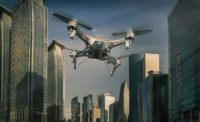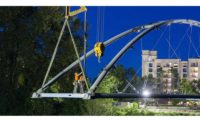Drones Used To Conduct Bridge Inspections in Minnesota

In a move to save time and money on bridge inspections, a Minnesota Dept. of Transportation consultant proposed the use of drones to do the work. MnDOT is now starting its second phase of testing the technology, and the results are promising.
"So far, it turned out really well," says Jennifer Zink, the bridge inspection engineer at MnDOT's Oakdale, Minn., bridge office who is managing the tests. The first phase of testing cost $35,000 and aims to find out how much bridge inspection work drones can take over for the department. The second phase will start in November, cost another $75,000 and employ a cutting-edge, rotary-wing drone made by the Swiss manufacturer senseFLY.
The drone used in the first phase was a military-grade fixed-wing model that is controlled via an onboard global positioning system. Getting it to complete the job was MnDOT's first hurdle.
The fixed-wing drone "would lose signal when flying under the bridge and automatically go back to its home base," says Zink. But it operated long enough to collect pertinent data about the bridge. Another problem is that the camera could look only down and side to side, not up.
Even with the limitations of a fixed-wing design, Zink's team started to see tangible benefits of drone inspections. They tested the approach alongside traditional physical bridge inspections, which use "snoopers"—basket-and-lift inspection vehicles that can position inspectors underneath a bridge.
"Some bridges take 10 or 11 inspectors to do the job, and that doesn't include the traffic crew," says Zink.
Since closing off traffic is part of the inspection, as Zink notes, it is another cost the use of drone technology could eliminate. But even if Zink's team of drones is able to accurately inspect the bridge, they cannot take over the job fully under current laws.
The Federal Highway Administration's National Bridge Inspection Standards state that a drone can be used to inspect a fracture-critical bridge span but cannot replace a crew of on-site inspectors. Therefore, drones represent only added cost.
"In doing the initial study, we learned we opened a can of worms," says Zink, referring to the legal parameters the department had to stay within.
MnDOT needed an exception from Federal Aviation Administration rules, so it hired a drone operator out of Colorado that had that exception under Section 333. In the fine print of Section 333, there is a rule that states the drone cannot fly within 500 ft of anyone who isn't the operator.
"I think FAA is loosening up more. We're looking into getting a less restrictive exemption on this drone so it can operate within 100 feet of people," says Zink, whose agency is banking on the hope that the FAA will loosen other exceptions in the future, as well, such as allowing drone-only inspections of fracture-critical bridge spans.
A new drone by senseFLY is specifically made to do those inspections, says Zink. A pilot-operated drone with a 360º camera, its rotors have rubber bumpers, so it can bounce off objects as if it were a bumper car.
Tests of the senseFLY drone will be performed on the Blatnik Bridge in Duluth, Minn., which Zink says is the largest bridge in the state. Partly fracture-critical, the bridge has two deck-truss spans, a tied-arch truss span and 40 girder approach spans. Zink says the drone inspection will be most helpful on those girder approach spans.






